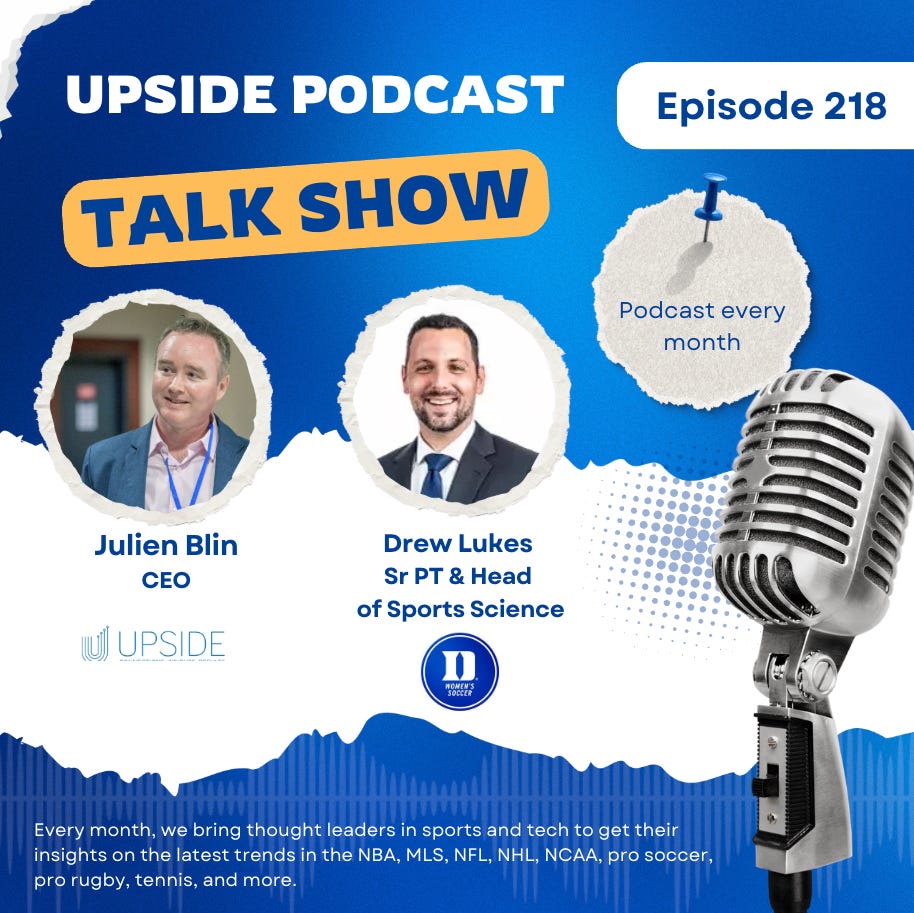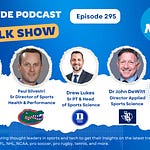Today we have the honor of interviewing Drew Lukes, the sr PT at Duke University and the head of sports science for Duke’s women soccer team.
📝Show Notes: Through this interview, we touched on his background, and his role at Duke University. We also touched on what his typical day looks like. We also discussed his approach towards innovation and biofeedback, and how important technologies are to help better train his athletes and help them recover faster. We also touched on some of his favorite technologies and what he is looking for when him and his team are looking to adopt a new technologies. Drew also shared his thoughts on how he sees technologies impacting Duke University from a performance training, and recovery perspective in the future.
You can read the full transcript of the podcast interview with Drew located at the top of this blog post.
Here are the quotes from the interview with Drew:
Q1. Please tell me about your background and your role at Duke University.
“My role is kind of twofold here. I'm primarily a physical therapist within our Murray Athletic Training Room, which serves all 20+ of our Olympic sports. During the day, I work with athletes from a variety of sports, helping them with rehab and injury recovery. In addition to that, I serve as the head of sports science for the Duke women’s soccer team, where I focus on data collection, performance monitoring, and injury prevention strategies.”
“My background is in physical therapy. I graduated from the University of Minnesota, then completed a sports physical therapy residency at the University of Wisconsin, followed by a Division I fellowship here at Duke. After completing my fellowship, I was hired on full-time and started getting more involved with the sports science side of things, helping build out data collection and analysis processes for our women’s lacrosse, volleyball, and soccer teams.”
Q2. What does your typical day look like at Duke University?
“One of the things I love most about my job is that every day looks different. It’s never boring. I feel like I wear multiple hats—one as a physical therapist during the day and another as a sports scientist in the evenings.”
“During the day, I primarily work on rehabs. I'm one of three full-time physical therapists in the Murray Athletic Training Room, which serves all our Olympic sports. So, at any given time, I could be working with a lacrosse player, a wrestler, a fencer, or an athlete from track and field. My job is to make sure these athletes are recovering properly, regaining strength, and getting back to competition safely.”
“Then in the evenings, I switch gears and put on my sports science hat. I spend time analyzing data, monitoring player performance, and providing insights for the women’s soccer team. It’s a lot of work, but it’s rewarding because I get to impact athlete performance from both a rehab and a sports science perspective.”
Q3. What is your approach towards innovation and biofeedback? How important are technologies to help better train your athletes and help them recover faster?
“For me, technology is an essential part of both rehab and performance monitoring. I use it daily to ensure I’m not overloading or underloading athletes, because the goal is always to hit that optimal training threshold. We don’t want to push them too hard and risk reinjury, but we also don’t want to be too conservative and delay their return.”
“I don’t ever want to be guessing when an athlete is ready to return to sport. That’s why testing and monitoring are so important. I want to be able to say with confidence that an athlete has regained the necessary strength, power, and movement patterns to safely return to play. That’s where technology plays a huge role.”
“From a biofeedback standpoint, sometimes less is more. I’ve found that simple tactile cues—like tapping an athlete’s quad—can be just as effective as advanced tech in helping them re-engage muscles properly. But when we do use biofeedback technology, I find tools like the Biodex and force plates extremely valuable because they provide real-time feedback and set measurable targets for athletes to reach during rehab.”
Q4. What are some of your favorite technologies that you use? Why?
“One of my favorite tools is the Biodex, which is an isokinetic testing machine. It gives me a really comprehensive snapshot of where an athlete is in their recovery. I can assess their brute strength, rate of torque development, and quad-to-hamstring ratios, which all help guide my rehab decisions. If an athlete’s strength is back but their ability to generate force quickly is lagging, that tells me we need to shift our focus.”
“Another technology I use a lot is force plates. We use them for jump testing, return-to-play evaluations, and even real-time biofeedback during squats. If an athlete is unconsciously favoring one leg, the force plates will show that immediately, and we can work on correcting it right away.”
“We also use Vault technology for biomechanical screenings and rehab testing. These tools help us measure strength imbalances, movement deficiencies, and overall readiness to return to play. The data we get from these tools allows us to make evidence-based decisions rather than just relying on subjective observations.”
Q5. When looking to adopt a new technology, what are the most important criteria?
“At Duke, we really try not to work in silos. If one team is looking to adopt a new technology, we ask: ‘Can this be useful for other teams as well?’ We want to make sure we’re making investments that benefit multiple programs.”
“The research behind a technology is important. But we also look at who’s funding that research. Is it a third-party study, or is it sponsored by the company selling the product? That makes a difference in how much we trust the data.”
“Feasibility is another key factor. Can we integrate this into our workflow without disrupting our day-to-day operations? If a technology takes too long to set up or requires too much manual input, it’s probably not worth it.”
“Price is always a big sticking point, especially in college athletics. We have to be strategic about where we invest. And something people don’t always think about is security. At Duke, we have strict security requirements, and if a technology doesn’t meet those standards, we simply can’t use it.”
Q6. In the coming years, how do you see technologies impacting Duke University from a performance training and recovery perspective?
“I think technology in this space is only going to grow. Five to seven years ago, if you wanted to do jump testing, you needed a full biomechanics lab with built-in force plates. Now, teams at all levels—including outpatient clinics—have access to affordable force deck systems. That’s a huge shift.”
“I also think wearable technology is going to keep advancing. We’re already seeing affordable IMU (inertial measurement unit) sensors that track acceleration, deceleration, and running mechanics. These tools used to be inaccessible to most programs, but now they’re becoming more affordable and easier to use.”
“From a sports science perspective, technology is becoming an expectation rather than a luxury. If you’re not using data to monitor your athletes, you’re going to fall behind. It’s one of those things where you either get on board or risk getting left behind.”
“Another interesting trend I see is the blending of physical therapy and sports science. More PTs are getting involved in data analysis, and teams are starting to look for dual-credentialed professionals who understand both rehab and performance monitoring. That’s something I think we’ll see more of in the coming years, especially in professional sports.”
You may also like:
🔥Upside Chat with Drew Lukes (Duke University/NCAA), Jordan Troester (University of Oregon/NCAA), Pierre Barrieu (Canada Soccer)
This week we had the honor to interview again a group of sports performance experts.
🔥Upside Chat with Andrea Hudy (UCONN/NCAA), Drew Lukes (Duke University/NCAA), Michael Messer (Nashville SC/MLS) on Commonalities & Differences Between the NCAA & MLS.
This week we had the honor to interview again a group of sports performance experts.
⭐ Upside Analysis: Why the NCAA is the Next Big Opportunity for Startups
We have been working with teams in the MLS, NBA, NFL, NHL, MLB, NCAA, European soccer leagues, pro tennis, pro rugby as well as Olympic teams for over 10 years. Historically most sports tech startups have focused on the top professional teams (NBA, NFL, MLS, MLB, NHL). However, in the past few years we have seen a large number of sports tech startups in…














